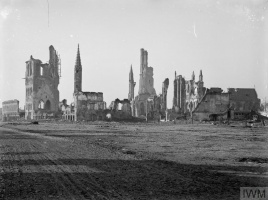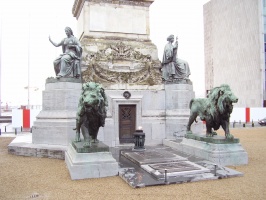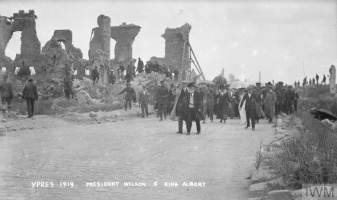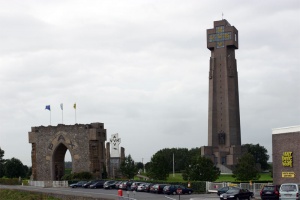Introduction↑
November 22, 1918. The royal family, the Belgian army, and representatives of the Allied forces paraded through the streets of Brussels. The day stands as the symbol of the end of the First World War. The conflict, however, left human, social, material, psychological, and cultural traces. Belgium was less affected than its neighbours, but still suffered significant damage. Most industries were forced to cease production and many people found themselves unemployed. The general population suffered from food deficiencies throughout the war. The financial situation was very complicated due to the introduction of the German mark and the cost of the occupation. Moreover, part of the road and railway infrastructure was destroyed. In other words, many challenges lay ahead. How would Belgian society be reconstructed in the 20th century?
The “Petite Revolution”, November 1918↑
The end of the First World War could be considered a small revolution. On 22 November 1918, Albert I, King of the Belgians (1875-1934) and the royal family paraded through the streets of Brussels, leading a 60,000-man delegation of the Allied armies. They partly followed the same route as did the king on 4 August 1914. On a symbolic level, the procession was an attempt to restore the honour of Belgium, trampled by the German attack. The parade took place a few days after the departure of the last German soldiers, who had left on the night of 15 November. Before their departure, these soldiers had gathered a council (Soldatenrat) and unsuccessfully attempted to fraternise with the Belgians. Part of the Belgian army remained mobilised as long as the state of siege was maintained, i.e. until late September 1919. In Brussels, the forty divisions of Allied soldiers, welcomed with joy in November 1918, were progressively becoming a nuisance. For some, the difficulty of this coexistence increased with the passing weeks. Loss of life continued on both sides. On 11 November alone, there were an estimated thirty to forty victims on the German side,[1] and at least eight amongst the Belgians.[2] Even if the war was over, these casualties contributed to the very palpable fear of social disturbance. In the preceding weeks, the Conference of Mayors of Brussels had met repeatedly to attempt to keep order after the German defeat, if necessary by implementing a temporary form of dictatorship.[3] This seemed justified in light of the violent events in the aftermath of the war. These occurred partly due to the material needs of the population, but also the tendency to take revenge on those who were suspected of having taken advantage of the war in one way or another: women who had had relationships with German soldiers (“femme à boche”), men who had enriched themselves, traitors, and other activists. Several days passed before order was reestablished in the capital city.
On 22 November, King Albert promised to expand suffrage to all men above over 21. Additionally he also announced plans to legalise the right to strike and to ensure linguistic equality. The last issue contained a more controversial proposal, namely the creation of a Dutch-language university in Ghent. Women remained largely disenfranchised, though they could hold office and vote in local elections. Only war widows and widows of men executed for patriotic reasons, war heroines, and female prisoners of war were allowed to vote. War widows lost this right if they remarried. Despite these limitations, the implementation of universal male suffrage implied a radical change in political culture: Belgium would henceforth be governed by coalitions instead of absolute homogeneous majorities.
Demographic Impact↑
Even if Belgium suffered relatively fewer military losses than its two main neighbours, the Great War made an impact there as well. More than 40,000 soldiers–including the missing in action–lost their lives, constituting around 10 percent of the army; the majority of casualties took place at the beginning of the war and during the final offensive in 1918. 5,521 civilians were killed during the German massacres of August 1914, and an estimated 3,000 died as a consequence of forced labor implemented by the occupying forces in 1916. The casualties from the Spanish flu are still difficult to estimate. Other deaths were due to the direct or indirect impact of the degradation of living conditions on a material level. Indeed, while newborns children were a major source of concern, older people were often left to themselves and, therefore, more vulnerable.[4]
In 1920, Belgium’s population numbered 7.4 million, more than half a million less than predicted. This was mostly due to a decrease in birth rate during the war. This explains the concern for natality that arose after the war. Women were celebrated as mothers and their presence in the labour market was considered an obstacle to a moral order centred on the family. As a consequence, the number of women in the workforce decreased from 31.3 percent in 1910 to 25.4 percent in 1930.[5]
The war had demographic impacts apart from mortality, profoundly marking Belgian people in their very flesh and souls. Beside the 40,000 dead, there were 80,000 injured, half of whom were still afflicted by a handicap. Physical suffering coexisted with deep and enduring psychological sequelae. The wounded had to find their way back to a dramatically altered family life and cope with the difficulties of securing a job and income. Aid from the state was calculated not on pre-war earnings, but on degree of physical impairment (as per the law of 23 November 1919 regarding war pensions).
Even for those who had returned physically intact, to be reunited with family was not as easy as expected. Soldiers’ wives had managed for themselves and their children had grown up. Due to the occupation, soldiers could not obtain leave and were rarely able to communicate with their families, to say nothing of those who had been held prisoners in Germany. The return was therefore often awkward. Whereas the majority of couples managed to regain a peaceful family life, the number of divorces increased from 1,207 in 1913 to 2,195 in 1920, and 3,665 in 1921, although we cannot confirm that mobilisation played a decisive role in this phenomenon.[6]
The end of the war also saw the return of half a million refugees who had stayed in France (352,000), the Netherlands (100,000), and England (163,000). No accommodations were provided for those whose houses had been destroyed. They were also mostly forgotten at official ceremonies.
The war also had material consequences: around 72,000 dwellings had been destroyed, and 200,000 were heavily damaged. Of course, this data obscures regional contrasts; the front zone was totally ravaged, the city of Ypres and its surroundings had been virtually obliterated. In other parts of the country, towns and villages still showed the consequences of the brutality of August 1914. Industrial infrastructure and communication networks were heavily damaged, not to speak of the dramatic food scarcity. The unemployment rate was so high that, in 1918, one-third of families needed relief. In other words, even though the demographic consequences were definitely less dramatic than in other countries, Belgium had still been ravaged and impoverished by the war.
Divided and Demanding Combatants↑
Although Belgian veterans did not have the status of French or German veterans, they too began to collaborate and unite. Belgians had mobilised at a lower rate than German, France, and Great Britain, with only 20 percent of men at the front. Therefore, combatants did not have the same significance as in the other countries. Even so, by November 1918, around 250,000 men had to be reintegrated into society; as the state of siege was prolonged, demobilisation was not immediately generalised.
As elsewhere, veterans created specific structures to support their material claims and their need for social recognition. Even before the end of the war, the idea of a future associative life had been evoked. The most important of these organisations was the Fédération nationale des Combattants (FNC), created in February 1919. The federation counted around 120,000 members in 1920. Other less important organisations existed as well (Fédération nationale des Invalides, Association nationale des combattants, Confédération des Combattants catholiques, Association des Combattants socialistes, etc.). The presence of multiple veterans’ groups was a reflection of the fragmentation of Belgian society, the consequence of political differences, sometimes of personal rivalry, of military hierarchy, or of power games. Among the numerous groups, the league of the Flemish veterans (Verbond der Vlaamse Oud-strijders – VOS) was notorious. Created in early 1917, its goal was twofold: to defend veterans’ material interests and to pursue the Flemish struggle. Despite its early birth, the movement was only effectively structured in the summer of 1919. It counted around 75,000 members in 1920. Eight were elected in the legislative elections of 1919: three on the Frontpartij list, and five on the Catholic Party list. Its claims were distinct from those of other veteran associations because the VOS wanted Dutch to become the only official language at the university of Ghent, alongside self-determination and amnesty. They were also against the Franco-Belgian Accord of 1920.
Although most traditional veteran associations officially refused to engage directly in the political arena, some, like the VOS, did not. During the legislative elections of 16 November 1919, the Parti des Combattants ran for office in Brussels, winning two seats. Another list, the Parti de la Renaissance Nationale, won one seat. Some veteran lists ran for office in the communal elections of 1921. Few won, but in three Brussels communes, the list “combattants” remained associated with the government until 1926. During the legislative elections of 1921, the Parti des Combattants won one seat before it disappeared completely. On the Flemish side, the Frontpartij was partly the project of Flemish veterans (Vlaams Frontbeweging)–former activists were among its founding members. Its programme focused on Flemish self-determination and rejection of the war. Five deputies from the list won in the elections of November 1919. Some veterans also joined traditional parties, but their numbers remained limited. On the one hand, veterans literally worshipped King Albert–even the Frontpartij recognised his goodwill and his respect for Dutch culture. On the other, they remained critical of politicians because they did not recognise veterans and because they considered politicians ineffective profiteers. These considerations held a certain amount of the “combatant spirit” which transcended ideological differences, as if an extension of an idealisation of unity born in the trenches. This critical stance nevertheless failed to truly challenge institutions.
The issue of endowments was particularly touchy, and veterans went as far as to organise a spectacular demonstration in July 1920. Payments for demobilised soldiers were calculated according to the number of years spent at the front and family situation, complemented by lump sums according to class and background. The veterans, strengthened by their moral capital, rapidly acted to obtain better compensation and priority on the labour market.
The first answer to the veterans’ claim was given in the law of 1 July 1919 regarding endowments for veterans. The measure was received coldly by veterans’ associations, which considered the sums insufficient and their implementation too slow. Discussions became strained in the difficult economic context. Unrest was at its peak in July 1920. After the king had received a delegation, 20,000 veterans took to the streets on 29 July 1920. The demonstration devolved and demonstrators entered the zone around the Parliament where manifestations were forbidden. Some managed to enter the Parliament building. In this tense climate, a new legislation was adopted on 25 August 1920. The veterans were largely satisfied. The new dispositions included the creation of a fund, le fonds du Combattant, which would bring together representatives of all the different associations. Despite the slow pace of implementation, around 335,000 files were dealt with between February 1922 and June 1923, corresponding to 80 percent of the total number of veterans.[7]
Monuments and Recognition↑
As in other belligerent countries, it was necessary to make sense of the four years of war and to create a cult of remembrance. The first action of the government to honour soldiers and civilians was to create registers, which were kept at the National Palace. The families received official diplomas indicating their presence on these lists.[8] Registers were also established locally, and several state funerals were organised. The cult of the dead was present everywhere. Despite the difficult economic context and heavily impacted public finances, the Belgian territory began to be covered by monuments. Demand came from below. The government, however, remained mostly deaf to local claims, and only a few monuments, celebrated for their artistic achievement, received state funding. The initial idea, never actually achieved, was to build a huge national monument. As a compensation, and under pressure from the veterans, the government finally accepted the idea of a ceremony at the Tomb of the Unknown Soldier, inaugurated on 11 November 1922.
Public subscriptions were launched for a number of other monuments, largely due to popular demand though the authorities’ participation was requested at all levels. As the dead were celebrated everywhere, every village and city wanted to have its monument, its memorial lawn. The local connection was essential: it was all about honouring “our” dead, “our” heroes, “our” martyrs. For families, it was out of the question to have their dead buried far from home. The authorities were compelled to pay for the transfer of graves in December 1920. There is no official data and it is impossible to know how many of these transfers actually took place.[9] Toponyms also began to feed the memory of the war, rendering homage to heroes but also to martyrs, underlining gratitude towards the Allies or exalting the fatherland and Belgian civilians. Thus, the years immediately after the war where full of honour ceremonies, victory celebrations, and monument inaugurations.
Beside the cult of the dead, those who had been engaged in the war were also celebrated with medals and statutes from Belgium and the Allies. Nevertheless, both civilians and combatants felt insufficiently recognised and compensated. This feeling was fused with the pernicious idea that traitors were not being punished, and that the latter ultimately fared better than those who had sacrificed themselves.[10]
Belgian Nationalism and Flemish Identity↑
The end of the war marked the triumph of Belgian nationalism, but also of the self-image Belgium had forged. The German attack of August 1914, followed by the sacrifices of the occupation and the triumphal return of the army, all contributed in one way or another to the victory of patriotism and the emergence of a war memory that would profoundly mark Belgian society. The Belgian context, however, was complex; the memory of the war was also nourished by a Flemish resentment which could hardly find its place in the midst of the Belgian nationalism. The gap between Flemish and Belgian identity would keep growing, even if in the immediate aftermath of the war there was not yet a clear-cut antagonism between the two.[11]
Progressively, however, the Flemish and Belgian memory of the war rooted itself in different places. If Belgian patriotism was gathered at the Unknown Soldier’s tomb on 11 November, the Flemish movement preferred the Yser, where its first gathering took place in 1920. The idea of the initiative was to honour the Flemish soldiers killed at the front. During the first years, the pilgrimage had a decidedly Catholic character (with the renown AVV-VVK slogan: Alles Voor Vlaanderen/Vlaanderen voor Kristus), but so-called maximalist currents, which claimed Flanders’ political autonomy, were also present.
Later, the pilgrimage committee erected a tower, the first stone of which was placed in 1928. At the tower, homage was rendered to a Flemish but also to a pacifist memory of the war, with a four-language banner: “No more war”. These shattered memories nourished a very specific war culture, the impact of which would not cease to influence the interwar period. This evolution was also due to the very anti-Flemish reaction of some francophone Belgians, who associated all–even the most moderate–Flemish demands with the occupiers’ Flamenpolitik. This Belgian nationalism, however, could also be very critical towards other forms of pacifism, as was shown during the episode of the “broken rifle”: the presence of Joseph Wauters (1875-1929), socialist minister of industry, labor and supply at a pacifist demonstration in October 1921 was harshly criticised by the right and provoked the resignation of all the socialist ministers. The accused minister claimed that the symbol of the broken rifle preceded the war and was a token in favour of disarmament and peace at an international level. For the Catholic First Minister, Henry Carton de Wiart (1869-1951), his presence was unacceptable;[12] for the socialist ministers, their resignation was an honourable exit, as elections drew near. This signified the end of the national union government, provoked by a quarrel directly related to the legacy of the war.
Conclusion↑
Beside material damage, the imprint of the war remained vivid in the minds of Belgians. The memory of the war was visible everywhere through monuments, in literary production, movies, and school books. However, it was also characterised by a growing fragmentation. Around the mid-1920s, the presence of the memory of the war began to decrease. The climate relaxed at the international level, with the Pact of Locarno and the adherence of Germany to the League of Nations. The experience of World War One fed the mobilisation of society both in a patriotic sense, but also with respect to the fear and rejection of war itself. In Belgium, however, two distinct and irreconcilable war memories emerged: one gathered the francophone world around a Belgian patriotic ethos, whereas the second displayed the colours of Flemish nationalism, the radicalisation of which influenced the following decade.
Chantal Kesteloot, Centre for Historical Research and Documentation on War and Society/State Archives
Section Editor: Benoît Majerus
Notes
- ↑ Majerus, Benoît: Occupations et logiques policières. la police bruxelloise en 1914-1918 et 1940-1945, Brussels 2007, p. 134.
- ↑ Gille, Louis / Ooms, Alphonse / Delandsheere, Paul: Cinquante mois d’Occupation allemande, vol. 4. Brussels 1918, p. 415.
- ↑ See Reports of the Conference of the mayors, October-November 1918, Archives of the City of Brussels and Gille / Ooms / Delandsheere, Cinquante mois 1918, pp. 346-347.
- ↑ See Marissal, Claudine: Protéger le jeune enfant. enjeux sociaux, politiques et sexués (Belgique, 1890-1940), Brussels 2014.
- ↑ Revue du travail, March 1935, p. 337 cited in Gubin, Eliane / de Smaele, Henk: Femmes et hommes en guerre, 19-191. Gender@war, Waterloo 2015, p. 161.
- ↑ Ibid., p. 149.
- ↑ De Bock, Stefan: Erkenning voor “onze helden aan den Ijzer”? Masterscriptie, University of Gent 2008-2009, pp. 66-67.
- ↑ See Claisse, Stéphanie: Du soldat inconnu aux monuments commémoratifs belges de la guerre 14-18, Brussels 2013.
- ↑ See ibid., p. 89.
- ↑ Debruyne, Emmanuel: Sortir de l’ombre – Des combattants clandestins en quête de reconnaissance, in: Tailler, Pieree-Alain / Nefors, Patrick (eds.): Quand les canons se taisent. En toen zwegen de kanonnen. When the Guns fall Silent, Brussels 2010, op.cit., pp. 449-479.
- ↑ De Waele, Maria: Belgisch Nationalisme, in: Nieuwe Encyclopedie van de Vlaamse Beweging, vol. 1. Tielt 1998, pp. 432-445.
- ↑ Procès-verbal of the Conseil de cabinet assembly, 19/10/1921, online: http://extranet.arch.be/ retrieved: April 2017).
Selected Bibliography
- Beck, Annelies: Ijzerbedevaart(en) (Pilgrimage of the Yser), in: Schryver, Reginald de / Wever, Bruno de / Durnez, Gaston (eds.): Nieuwe encyclopedie van de Vlaamse Beweging (New encyclopedia of the Flemish movement), Tielt 1998: Lannoo, pp. 1503-1514.
- Colignon, Alain: Les anciens combattants en Belgique francophone 1918-1940, Liège 1984.
- De Bock, Stefan: Erkenning voor 'onze helden aan den Ijzer'? (Recognition for 'our heroes of the Yser'?), thesis, Ghent 1111: Ghent University.
- Eggerickx, Thierry: L’impact démographique de la Première Guerre mondiale. Tendances générales et diversités spatiales, in: Hasquin, Hervé (ed.): La bataille de Charleroi. 100 ans après, Brussels 2014: Académie royale de Belgique, pp. 105-135.
- Gerard, Emmanuel: La démocratie rêvée, bridée et bafouée. Nouvelle histoire de Belgique 1918-1939, Brussels 2010: Cri.
- Gubin, Eliane / De Smaele, Henk: Femmes et hommes en guerre, 1914-1918, Brussels 2015: Renaissance du Livre.
- Jaumain, Serge / Amara, Michaël / Majerus, Benoît et al. (eds.): Une 'guerre totale'? La Belgique dans la Première Guerre mondiale. Nouvelles tendances de la recherche historique, Brussels 2005: Archives générales du Royaume.
- Lemens, Peter: Verbond der Vlaamse Oud-strijders (Association of Flemish War Veterans), in: Schryver, Reginald de / Wever, Bruno de / Durnez, Gaston (eds.): Nieuwe encyclopedie van de Vlaamse Beweging (New encyclopedia of the Flemish movement), Tielt 1998: Lannoo, pp. 1503-1514.
- Rousseaux, Xavier / van Ypersele, Laurence: La patrie crie vengeance! La répression des 'inciviques' belges au sortir de la guerre 1914-1918, Brussels 2008: Le cri.
- Tallier, Pierre-Alain / Nefors, Patrick (eds.): Quand les canons se taisent. Actes du colloque international organisé par les Archives de l'État et le Musée royal de l'Armée et d'Histoire militaire (Bruxelles, 3 - 6 novembre 2008) (When the guns fall silent), Brussels 2010: Archives générales du Royaume.
- van Ypersele, Laurence; Tixhon, Axel: Célébrations de Novembre 1918 au royaume de Belgique, in: Vingtième Siècle. Revue d'histoire 67, 2000.
- Verstraete, Pieter / Van Everbroeck, Christine: Le silence mutilé. Les soldats invalides belges de la Grande Guerre, Namur 2014: Presses universitaires de Namur.














